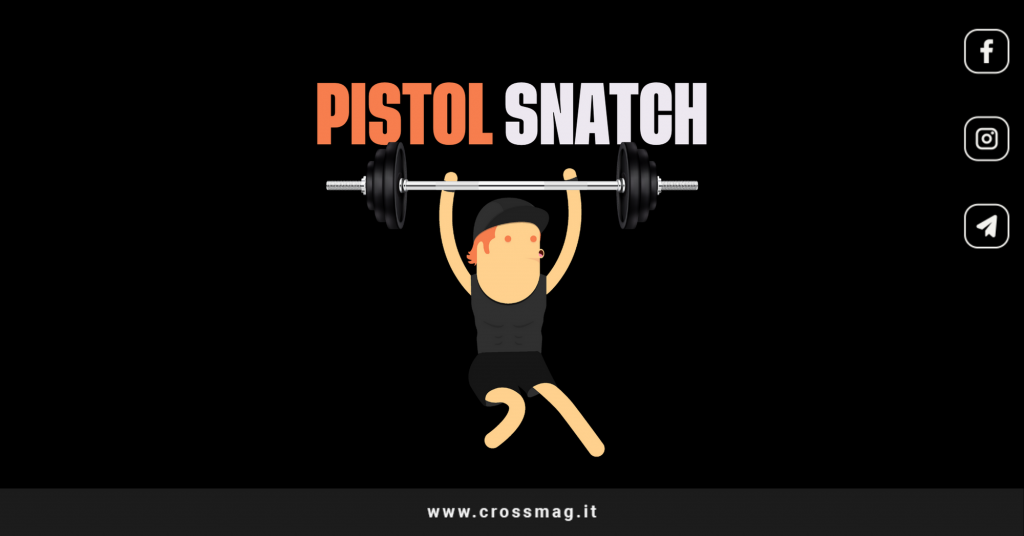If you're looking for a challenge, we have just the thing for you: the Snatch Gun! This challenge is one bold fusion of two iconic CrossFit® movements, the snatch and pistol squats, is requires force, balance and agility.
To meet this challenge, it is obviously It is necessary to master both skills. Here is the challenge:
Index
Snatch pistol: because it's complicated
This challenge is complicated for several reasons, which arise from the complexity and precision required to correctly execute this movement in the context of CrossFit.
Here are some of the key reasons:
- High Technical Requirements: The Snatch Pistol requires technical mastery of two advanced movements: the snatch and the pistol squat. Both require proper coordination, strength and joint mobility. Accurate execution of both movements is essential to blending them into the Snatch Pistol.
- Complex Balancing: The pistol squat is a movement that involves performing one squatting on one leg. Combining this movement with the snatch adds a significant level of complexity, as you must maintain balance while lifting the barbell overhead. This combination requires considerable stability and control.
- Specific Muscle Strength: this challenge tests muscle strength in a specific way. It requires a powerful explosion in the snatch phase and considerable leg strength to perform the pistol squat. The muscles involved must work in harmony, requiring complete physical preparation.
- Requires Joint Mobility: Both movements, the snatch and the pistol squat, require good joint mobility. Flexibility in the hips, knees and ankles is critical to performing the pistol squat correctly, while shoulder mobility is essential for the snatch. A deficit in any of these areas can complicate the execution of the Snatch Pistol.
- Specific Training: To master these movements, targeted and constant training is necessary. The challenge is not only physical but also requires an in-depth understanding of the movements involved. Athletes must dedicate time and effort to perfect their technique and develop the necessary strength.
What muscles do you train?
As mentioned before, the Snatch Pistol is a complex movement that involves multiple muscle groups, requiring strength, balance and coordination.
Here are the main muscles involved in the Snatch Pistol:
- Quadriceps: The pistol squat, which is an integral part of the Snatch Pistol, is a movement that puts intense strain on the muscles quadriceps. These are located at the front of the thigh and are responsible for knee extension.
- Hamstrings (Biceps Femoris, Semitendinosus, Semimembranosus): These muscles located at the back of the thigh are involved in knee flexion, a necessary movement during the pistol squat.
- Buttocks: I buttocks, especially the gluteus maximus, are actively involved during the pistol squat, as they are responsible for hip extension.
- Core Stabilizer Muscles: To maintain balance while performing the Snatch Pistol, the stabilizer muscles are involved core, including the abdominal and lower back muscles.
- Upper Body Muscles (Deltoids, Trapezius, Triceps): The snatch, which is an integral part of the Snatch Pistol, involves the upper body. THE deltoids (shoulder muscles), the trapezius and triceps are worked when lifting the barbell overhead.
- Hip flexors: The hip flexor muscles are active during the pistol squat, aiding in hip flexion when lowering into a single-leg squat.
- Calves: During the pistol squat, the muscles of calf, such as the gastrocnemius and soleus, are activated to stabilize the knee and aid in balance.
- Adductors and Abductors: During the descent and ascent phase of the pistol squat, the adductor muscles (on the inside of the thigh) and the abductors (on the outside of the thigh) are involved in stabilizing the leg.
The Snatch Pistol is therefore a highly integrated movement that involves a wide range of muscles, requiring a balance between strength and coordination. Specific training of these muscle groups is essential to master this movement in the context of CrossFit®.
So, who wants to try this new challenge?

